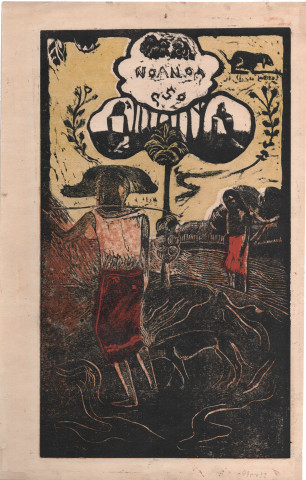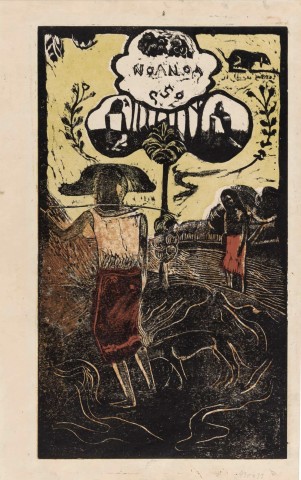Noa Noa, 1893-4
Color woodcut, from the edition of approximately 25-30, printed by Louis Roy, Paris, with full margins,
Image 14 x 8 1/8 inches; 356 x 206 mm.
Sheet 15 3/4 x 9 13/16 inches; 400 x 249 mm.
%3Cdiv%20class%3D%22artist%22%3E%3Cstrong%3EPaul%20Gauguin%3C/strong%3E%3C/div%3E%3Cdiv%20class%3D%22title_and_year%22%3E%3Cem%3ENoa%20Noa%3C/em%3E%2C%20%3Cspan%20class%3D%22title_and_year_year%22%3E1893-4%3C/span%3E%3C/div%3E%3Cdiv%20class%3D%22medium%22%3EColor%20woodcut%2C%20from%20the%20edition%20of%20approximately%2025-30%2C%20printed%20by%20Louis%20Roy%2C%20Paris%2C%20with%20full%20margins%2C%3C/div%3E%3Cdiv%20class%3D%22dimensions%22%3EImage%2014%20x%208%201/8%20inches%3B%20356%20x%20206%20mm.%20%3Cbr/%3E%0ASheet%2015%203/4%20x%209%2013/16%20inches%3B%20400%20x%20249%20mm.%20%3C/div%3E
Ever seized by wanderlust, Paul Gauguin sought to abandon the European life he viewed as conventional and artificial in favor of one in tune with nature and free of the...
Ever seized by wanderlust, Paul Gauguin sought to abandon the European life he viewed as conventional and artificial in favor of one in tune with nature and free of the constraints of Western social mores. In search of a more vital and authentic way of life, he made his first sojourn to Tahiti in 1891. Although the island was not the untouched Eden he had hoped for, he was still greatly inspired by the people, culture, and lifestyle there, and these new influences were reflected in his paintings, sculptures, and drawings. After he returned to Europe in 1893, he began working on Noa Noa (Tahitian for "fragrance"), a book project based on his Tahitian experience and illustrated with woodcuts that were meant to make his new art more understandable to his contemporaries. Although never realized in their intended form, both the text and the ten woodcuts for Noa Noa survive among Gauguin's seventy-eight printed compositions in woodcut, etching, and lithography.
The Noa Noa woodcuts illustrate everything that drew Gauguin to printmaking. Although the woodcut had seen a modest revival in the nineteenth century, no example matched the audacity of Gauguin's approach to the medium, which allowed him to work on a natural, "primitive" matrix, creating works that combined the sculptural gouging of his carved wood low reliefs with the evocative color of his paintings. It also provided seemingly endless opportunity for experimentation. Gauguin printed Noa Noa blocks with various inkings and color combinations, on different papers, and sometimes slightly off-register to create a blurred, dreamlike image, as in The Gods. In addition to the Noa Noa woodcuts printed by the artist, impressions were also pulled by the professional printer Louis Roy during the artist's lifetime; others were produced posthumously by Gauguin's son, Pola, and by others.
Publication excerpt from an essay by Sarah Suzuki, in Deborah Wye, Artists and Prints:
Masterworks from The Museum of Modern Art, New York: The Museum of Modern Art, 2004, p. 42.
Provenance
Ismar Littmann Family Collection
Collections:Atlanta, High Museum of Art
Chicago, The Art Institute of Chicago, ec Charles Morice
Chicago, The Art Institute of Chicago,ex Paco Durrio
Paris, Musee National des Arts Africaines et Oceaniens, 4 copies
Chicago, The Art Institute of Chicago
Boston, Museum of Fine Arts
Stockholm, National Museum
Bern, Kunstmuseum
Washington, DC, National Gallery of Art
New York, Museum of Modern Art
London, British Museum
Publications
E.
Mongan, E.W. Kornfeld and H. Joachim, Paul Gauguin: Catalogue Raisonné of His Prints, Bern, 1988, pp. 150-55, no. 13
(another example
illustrated).



